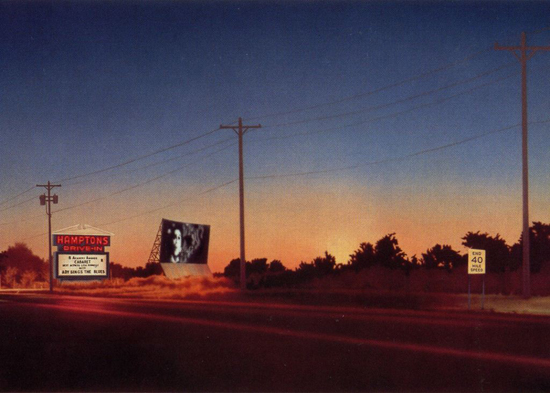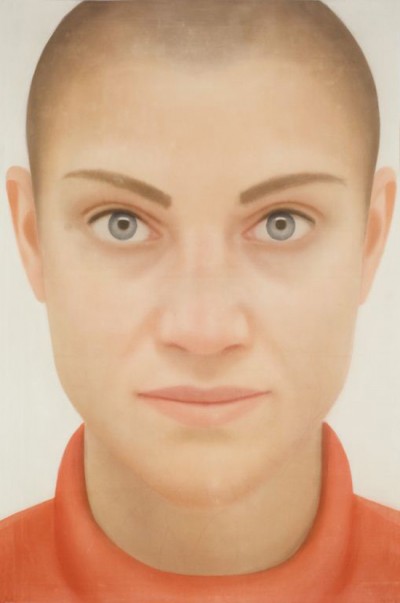DISPATCH - APRIL 8, 2013 (8:05 a.m.)
WATER MILL, NY-
A sleeper at the Parrish Art Museum is three themed exhibitions composed of works from the museum's permanent collection. Opening quietly on March 9, the trio closes just as quietly tomorrow. Worth seeing are "Face Value," "Land, Sea, Sky" and "Selected Recent Acquisitions: Building a Collection." Each exhibition is sublime in its own way. All three contain works by artists of the Hamptons and more.
"Land, Sea, Sky" presents a single work by five artists: Robert Dash, Clifford Ross, Fairfield Porter, Jane Wilson and Tria Giovan. A mix of painting and photography, the art seamlessly presents landscapes of the past with those of the present. Each landscape reflects a beloved view of the artist who portrayed nature in art.
Robert Dash's Evening Blow is a moving example of his work. The painting captures a moment in Sagaponack, NY, where Dash can be frequently found in at the Madoo Conservancy--a two-acre organic garden and seasonal education center established by the artist. Evening Blow channels the sensation of the wind rolling off the surface of the nearby ocean and blowing along Sagg Main Street past Foster's Farm, according to the Parrish.
.

"Evening Blow" by Robert Dash, 1972. Acrylic on canvas, 72 x 108 inches. Courtesy Parrish Art Museum.
.
Jane Wilson's painting The Wave is equally inspired by the sea and her experience of living close by. The work also draws inspiration from the Midwestern flat lands of her childhood.
“My paintings,” she has said, “come out of my efforts to get color to embody the atmosphere we all live in.”
.
"Land, Sea, Sky" includes a photograph of the ocean beach in Sagaponack by Tria Giovan, a photograph of a storm-tossed sea captures at Georgia Beach by Clifford Ross, and a painting by Fairfield Porter (1907-1975) set near his summer home of Great Spruce Head Island in Penobscot Bay, ME. Porter lived in Southampton, NY in the latter part of his life and was married to the poet Anne Porter.
An edgy contemporary look at landscape art can also be found in "Selected Recent Acquisitions: Building a Collection." In these works, the landscapes capture a time lost or represent horror and push past the expectation of traditional landscapes.
Arguably, the strongest example is Donald Sultan's Polish Landscape II, Jan. 5, 1990 (Auschwitz). The painting, made of latex and tar on tile and mounted on masonite panels, is an interpretation of the manmade landscape of Auschwitz, the World War II concentration camp based in Poland.
Hamptons Drive-In by Howard Kanovitz (1929-2009) relays a different type of history. Glowing with nostalgia that mixes longing and sadness, the painting is an emotional one of times gone by and of obsolesce. In keeping with the hyperrealism of Kanovitz's art, the painting of the former Bridgehampton roadside landscape includes touches of minute detail.
.

"Hamptons Drive-In" by Howard Kanovitz, 1974. Acrylic on canvas, 42 x 90 inches. Image courtesy of the Parrish Art Museum.
.
Additional contemporary landscapes in the show include Rackstraw Downes's Currie Woods Housing Project, Jersey City, Buildings One and Three, Vacated and Fenced for Demolition and Julia Oschatz's Untitled (012-05).
"Selected Recent Acquisitions: Building a Collection" also presents art demonstrating a range of abstraction by artists of the Hamptons. Works include paintings by Dan Christensen, Louisa Chase, Eric Freeman, Dorothea Rockburne and John Torreano.
Ross Bleckner's Architecture of the Sky seems to straddle abstraction and landscape with its upsweeping patterned motion set on a field of white and dappled grays.
.

"Architecture of the Sky" by Ross Bleckner, 1990. Oil on canvas, 106 x 92 inches. Courtesy Parrish Art Museum.
.
"Face Value" presents four artworks--one on each wall--by Chuck Close, Till Freiwald, Richard Avedon (1923-2004) and Robert Henri (1865-1929). All are large works that command examination from far and near.
Perhaps the most commanding is Freiwald's enormous portrait Untitled.
Freiwald’s watercolor portraits are made through a painstaking process of blending layers of translucent color to achieve an otherworldly glow, according to the Parrish. Freiweld's process begins with a direct encounter with his subject which result in small-scale sketches made from the photograph. He then sets everything aside and makes monumental watercolors from memory to capture what the artist describes as the "main characteristics of the face,” according to the museum.
.

"Untitled" by Till Freiwald, 1997. Graphite and watercolor on paper, 92 x 60 inches. Courtesy Parrish Art Museum.
.
Close's mixed media portraits are also oversized. Each relies on a process that combines photography, printmaking and painting. Close begins his paintings with a photograph, grids the image and methodically transfers the information, square by square, to a larger format.
“Any innovation that is evident in [my] paintings,” Close has said, “is a direct result of something that happened in the course of making a print.”
Works by Avedon and Henri on view are also large-scale but provides distance from a face-to-face encounter.
Henri's painting "Lady in Black," ca. 1904, is a striking one. Henri (1865-1929) was a member of the so-called "apostles of ugliness” (later known as the “Ashcan School”) whose art was characterized by a dark palette and depictions of the grittier side of urban life. While dark, the works were also infused with empathy and humanity.
The "Lady in Black" is Henri's wife Linda, who died following a long illness soon after this portrait was completed.
Avedon's photograph The Generals of the Daughters of the American Revolution, DAR Convention, Mayflower Hotel, Washington, DC was made while on a commission of an official portrait of the leaders of the Daughters of the American Revolution at their annual convention in Washington, D.C.
Avedon made the portrait but then made another "unofficial" candid image of the women. The impetus for making the image was the memory of a reaction Avedon had as a teenager to a 1939 news report that the D.A.R. refused to let the great African-American soprano Marian Anderson perform in Washington’s Constitution Hall because of her race, according to the Parrish. While photographing the 1963 leaders of DAR, Avedon decided to make his own portrait of the assembled "Generals," which is currently in the Parrish's collection.
BASIC FACTS: “Face Value,” “Land, Sea, Sky” and “Selected Recent Acquisitions: Building a Collection” are presented from March 9 to April 9, 2013 at the Parrish Museum, 279 Montauk Highway Water Mill, NY 11976 www.parrishart.org.
________________________________________
© 2013 Hamptons Art Hub LLC. All rights reserved.

